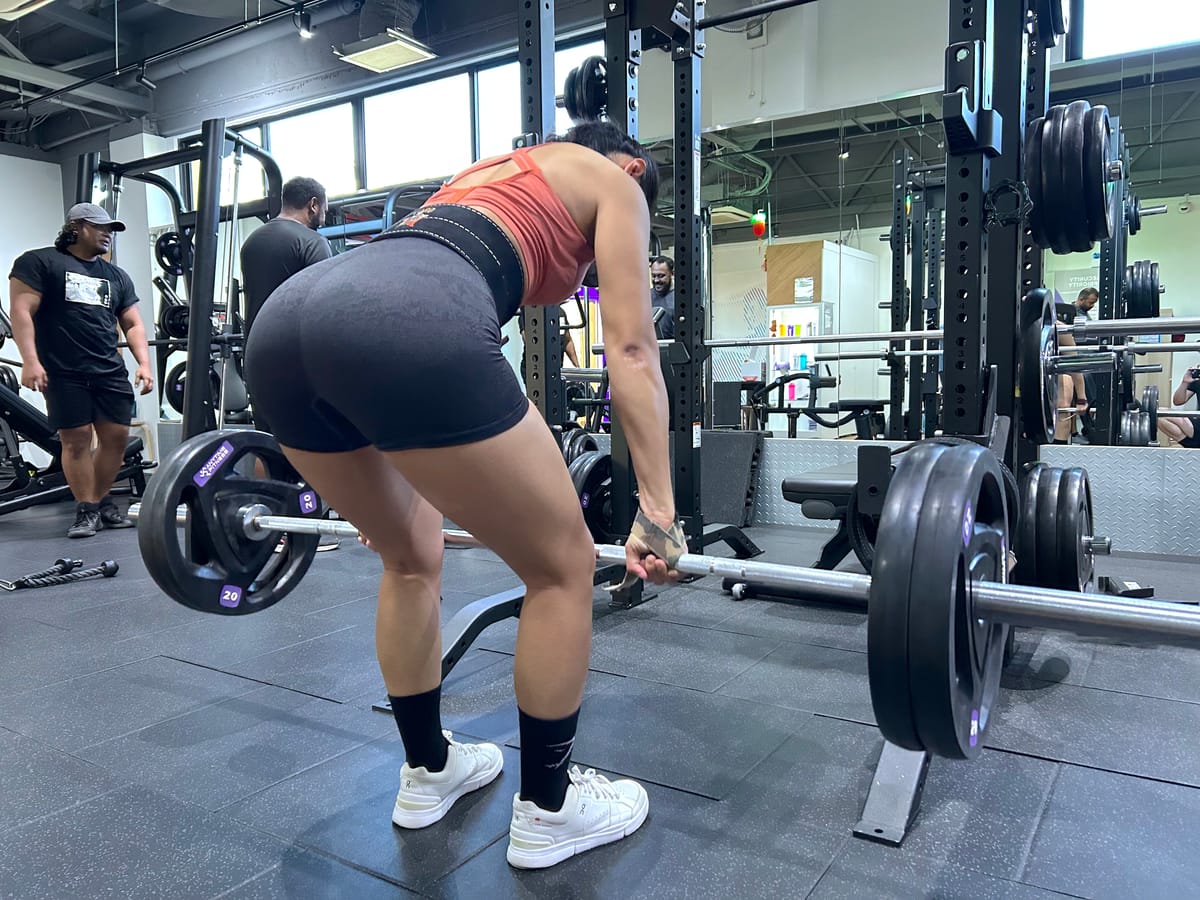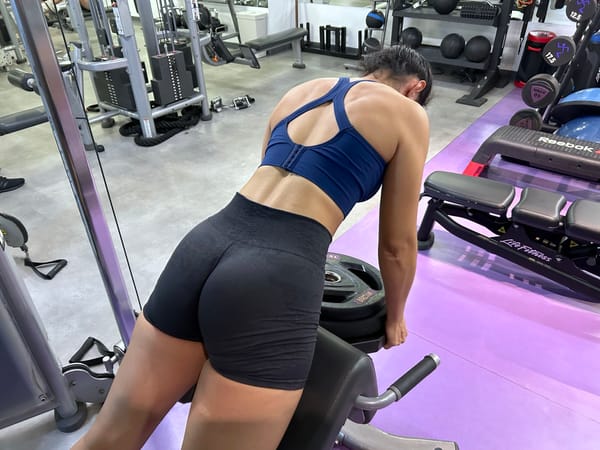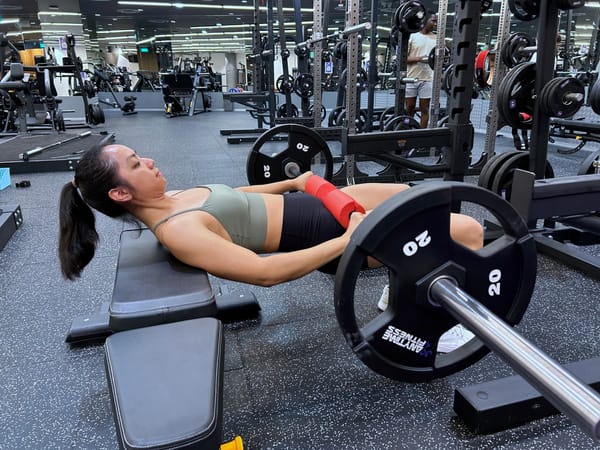How to Get a Bigger Butt (Science-Based Exercises and Tips)
Learn how to get a bigger butt so those ridonkulous perky peaches of your dreams turn into reality instead of remaining an out-of-reach fantasy.

Learning how to get a bigger butt is the first thing on many people's minds. And why not? It's a statement piece that could elicit this response from others:
If that’s the kind of reaction — an intoxicating ego-boosting blend of admiration and jealousy — you’d like when you walk past someone, you’re in the right place.
To (badly) paraphrase Hall of Fame football coach Vince Lombardi, “Great butts aren’t born, they’re made.”*
And how can you make yourself a great butt?
Answer: through understanding the specific functions your butt muscles perform, then selecting the appropriate exercises that target them.
*The original quote is, “Leaders aren’t born, they are made.”
So, without further ado, here’s how to get a bigger butt. Starting with an exploration of your butt muscles anatomy.
Butt muscles anatomy
Your glutes consist of 3 butt muscles.
Gluteus maximus
The biggest, most visible, and powerful of all your butt muscles.
Its primary function is the hip extension or, in other words, the movement of driving your hips forward, like in a deadlift.
Gluteus medius
The second-biggest of your butt muscles that wraps around the sides of your upper butt.
When well-developed, the gluteus medius helps create the coveted look of round, 3D, juicy glutes.
It helps with hip stabilization and plays the primary function of hip abduction (i.e., moving your thigh away from your body’s midline), like in a hip abduction machine.
Gluteus minimus
The smallest of your butt muscles.
Because it’s located directly under the gluteus medius, it’s also responsible for hip stabilization and abduction.
How to get a bigger butt: just do squats?
One of the most common misconceptions about how to get a bigger butt is that all you need are squats.
But that’s misguided.
While squats are amazing for growing your glutes, they’re not enough for optimal butt development.
For 2 reasons:
4 types of glute exercises for a bigger butt
A recap of what we’ve learned about how to build a bigger butt: you need both hip extension-, and abduction-focused work.
And it also appears not all hip extension movements are made equal. Some, like squats, preferentially target the lower glutes, while others target the upper glutes.
On that note, here are the 4 types of glute exercises for a bigger butt:
- Squat/lunge exercise: Preferentially targets the lower glutes. Provides the most amount of tension on the glutes when they’re in a fully stretched position.
- Hinge/pull exercise: Preferentially targets the lower glutes. Also provides the most tension on the glutes when they’re in a fully stretched position.
- Thrust/bridge exercise: Preferentially targets the upper and lower glutes. Provides the most tension on the glutes when they’re in a fully contracted position.
- Abduction exercise: Preferentially targets the gluteus medius and minimus.
At this point, I need to issue an important disclaimer.
“Preferentially targets” does not mean the same thing as “exclusively targets”.
Squat/lunge glute exercises, for example, will still activate the upper glutes, plus potentially your gluteus medius and minimus.
Your glute muscles (or any muscles, really) work together, which means you cannot truly isolate either the upper glutes, lower glutes, or gluteus medius/minimus.
Alright.
Now that we’re on the same page, let’s work through 2 glute exercises from each of those categories.
#1: Squat/lunge glute exercises
Butt muscles preferentially targeted: gluteus maximus (lower glutes)
Bulgarian split squat
Equipment needed: Dumbbells and a bench
It seems like we’ll have to learn how to revel in the pain of Bulgarian split squats because they’re one of the most effective glute exercises out there.
The Bulgarian split squats offer 2 distinct advantages over even the Greatest Of All Time (GOAT), barbell back squats.
A deeper stretch
Elevating your back leg on a bench for the Bulgarian split squat increases the range of motion your glutes go through at the bottom position.
Research on other muscle groups (e.g., quads, triceps, and biceps) suggests that training at long muscle lengths — where the muscle is fully stretched — could help maximize growth.
And while we still need more glutes-specific studies, it’s likely your booty would benefit from being trained in a deep stretch position.
Unilateral exercise
You’d be loading 1 glute at a time. This allows you to work on or prevent the development of any muscle imbalances (unevenly-sized glutes aren’t a good look).
But the Bulgarian split squats can be tricky to get right, so here are a few tips on how to get a bigger butt with the Bulgarian split squat:
Find your stride length by sitting on your bench, then straightening out your working leg. Where your foot lands is where you start your split squat. From there, simply stand up, set your back leg up on the bench — and go crazy!
Your stance should be around shoulder width. Keep your working leg vertically under your shoulder. What you want to avoid is a narrow stance that affects your balance and limits your performance. Think about how hard it is to walk on a narrow plank — you don’t want that.
The forward lean puts your torso roughly parallel to your shin (at the bottom position). Compared to having a more upright torso, this forward lean allows for a greater range of hip extension to better target your glutes. Avoid overdoing this however as you could risk putting your spine out of its neutral position.
Your front leg is supposed to be handling most of the weight in this exercise. Avoid shifting too much weight to your back leg since its main role is to stabilize, not do the lifting for you.
This keeps the weight on your front leg as much as possible. “Sitting back” on the way down would shift more weight to your back leg, which is not what you’re looking for here.
This distributes the pressure evenly across your entire foot. It keeps your setup stable and maximizes the force you can generate. We all know how shaky Bulgarian split squats can get.
To set up and perform the Bulgarian split squat:
Deficit reverse lunge
Equipment needed: Dumbbells and a bench
This is pretty similar to the Bulgarian split squat, only … well, in reverse. Because of that, it offers the same benefits (i.e., deeper stretch in the glutes and helps with muscle imbalances).
Of course, instead of elevating your back leg (like in the Bulgarian split squat), you’re elevating your front leg this time.
Note that similar tips apply — stride length, forward lean in torso, and force production — so refer back if needed.
To perform the deficit reverse lunge:
#2: Hinge/pull glute exercises
Butt muscles preferentially targeted: gluteus maximus (lower glutes)
Barbell Romanian deadlift (RDL)
Equipment needed: Barbell
Why the barbell instead of dumbbells?
TBH, it has a lot to do with personal preferences. But beyond that, it’s also because the barbell Romanian deadlift makes it easier to progressive overload over time — it’s challenging to pick up 2 x 40 kg dumbbells off the floor, for example, but much easier to deadlift the same weight with Olympic/bumper plates.
If needed, you could even avoid picking the weights off the floor altogether (so you save all that lower back strength for during the set instead of before it) by placing the barbell on the safety catches of a squat rack.
And now, a few tips on how to get a bigger butt with the Romanian deadlift:
Bracing stabilizes your spine, lowering the risk of loaded spinal flexion (bending forward) or hyperextension (arching backward) and, in turn, lower back injuries. An important thing to remember is that bracing isn’t about contracting your abs or “drawing down” your core. Instead, it’s about expanding your core, “pushing” it outwards in all directions as if you were getting ready for a heavy punch to the stomach.
This helps you to drive your hips backward further — allowing your hamstrings to hit a deeper stretch and maximizing your hip extension.
A common mistake many people make with the Romanian deadlift is allowing the barbell to drift away from the body. This puts a lot of unnecessary strain on the lower back. So, make sure you engage your lats (it should feel like you’re trying to pull the barbell “into you”) throughout the movement to have the barbell maintain contact with your thighs at all times.
Some people can lower the barbell to the floor on the Romanian deadlifts without rounding their lower backs. But don’t go chasing that insane depth just yet. What you want is to train safely at your current mobility. Do that by driving your hips back horizontally (as far as you can), and once you’ve reached your limit, stop descending further. Reverse the movement and return to your start position. For those new to the movement, you would typically expect your barbell to be around knee level.
To perform the barbell Romanian deadlift:
45-degree hip extension (back extension)
Equipment needed: Back extension machine
New to the gym and struggling to get the hip hinge movement right?
Then I recommend leaving the barbell RDL for now — and working with the 45-degree hip extension (or back extension) for a start.
By keeping your lower body in place, the hip extension machine allows you to focus on 1 movement: hip hinge. So use this to build a strong foundation and use more weight over time (for progressive overload).
The strength and technique you build here will carry over to the RDL.
Pay attention to the setup of the machine.
The pad (your quads are pressed into) should be at the right height: just below your pubic bone. This lets you move through the full range of the 45-degree hip extension while keeping a neutral spine.
I recommend using barbells (instead of weight plates) because it’s just much easier to load and so much safer for your fingers.
Here are a few tips on how to get a bigger butt with the back extension:
EMG studies show this may help you preferentially target your glutes over your hamstrings.
It’s like, um, a thrusting movement. *ahem* Enough said.
This sweet spot lets you perform the exercise safely through its full range of motion.
To perform the 45-degree hip extension:
#3: Thrust/bridge glute exercises
Butt muscles preferentially targeted: gluteus maximus (upper and lower glutes)
Barbell hip thrust
Equipment needed: Barbell, hip thrust pad, and a bench OR Smith machine, hip thrust pad, and a bench
Of all the exercises you could do for a bigger butt, there isn’t a single “best glute exercise” that’s clearly superior to all. But there’s one that everyone knows as “the butt exercise” for these 2 reasons.
Targets upper and lower glutes
Squat/lunge movement = predominantly lower glute butt muscles. Hinge/pull = predominantly upper glute butt muscles. The barbell hip thrust, as a thrust/bridge movement, offers the best of both worlds by targeting both your upper and lower glute muscles 🎉.
Easy to progressive overload
Want to increase the weights? Just slap on additional weight plates to the sides of your barbell or Smith machine barbell, and you’re done. You can even add resistance bands to your setup easily.
Here are a few tips on how to get a bigger butt with the barbell hip thrust:
Having your feet placed too far from the bench increases activation of your hamstrings, while having them too near the bench increases activation of your quads. Ensuring vertical shins when your glutes are fully contracted at the top of the movement helps you maximize activation in your butt muscles.
👉 The first is the “scoop” or posterior pelvic tilt (PPT) method.
This is where you’re keeping your chin tucked, “scooping” the weight up, and posteriorly tilting your pelvis into lockout.
👉 And the second is the hinge method.
Here, you think of your head, neck, and torso as a solid, straight unit. You should face the ceiling at lockout.
Both methods are correct; whichever you choose ultimately comes down to personal preferences (i.e., which feels more comfortable for you?)
That said, regardless of which method you use, always maintain a neutral back throughout.
To perform the barbell hip thrust:
To see PPT vs. hinge method hip thrust:
Glute bridge
Equipment needed: None
Can’t find a bench or box you can do your barbell hip thrusts on? Or simply prefer a simpler setup?
You can still work your upper and lower butt muscles with the glute bridge!
Just like the barbell hip thrust, the glute bridge can be done with a barbell, dumbbells, or just plain old bodyweight. The only difference is that your shoulders are on the floor (instead of being elevated on a bench).
Here are a few tips on how to get a bigger butt with the glute bridge:
This preferentially targets your glutes instead of your hamstrings or quads.
It’s a shorter range of motion than the hip thrust, but the principles are the same. Contract your glutes hard at lockout.
Here’s a caveat: as you progress to heavier weights, the glute bridge might become more cumbersome because of these reasons:
- Harder to hold the weight in place: The weight moves upwards and backward in the glute bridge. As it gets heavier, it’d be more challenging to hold the weight in place on your hips. And we all know how much weight our butts are capable of thrusting!
- Sliding back due to momentum: Your shoulders are more likely to slide backward when you thrust with heavier weights. Especially so when you’re going through heavy, explosive reps. This would put you out of the optimal position as your shins will now be tilted back.
If these factors are limiting your progression, you could go with the barbell hip thrust — or switch to a single-leg variation of the glute bridge (single-leg glute bridge or B-stance glute bridge).
To perform the glute bridge:
#4: Abduction exercises
Butt muscles preferentially targeted: gluteus medius and minimus
45-degree glute kickback
Equipment needed: Cable machine and ankle cuff attachments
Most people perform the glute kickbacks by kicking directly backward, which works the gluteus maximus.
While there’s technically nothing wrong with that, it isn’t the “best use” of this exercise because it’s rather difficult to hit the amount of weight needed to meaningfully work your powerful gluteus maximus in the long term without straining your lower back.
And especially since, as mentioned earlier, there are plenty of other glute exercises that’ll help you work your upper and lower glutes.
Given all that, the (45-degree) glute kickback is more suited for your smaller butt muscles (i.e., gluteus medius and minimus), which can be appropriately challenged with moderate weights.
Here are a few tips on how to get a bigger butt with the 45-degree glute kickback:
Yes, it’s a 45-degree glute kickback, but you don’t have to be, for a lack of a better word, anal about it. Your glute medius and minimus wrap around the sides of your booty, so theoretically speaking, kicking sideways (anywhere in the 30 to 45-degree range) would preferentially activate them over your gluteus maximus.
Only kick back as far as you’re still able to maintain a neutral spine. Overarching your back (i.e., going into an anterior pelvic tilt) puts you at risk of hurting yourself. Brace your core and avoid using too much momentum.
Don’t yank or “explode” your way to the top. Neither should you allow the weight to pull you back to the starting position at the end of each rep. Instead, make sure you control the concentric and eccentric portions with your glutes; if you can’t, then it’s a sign you’ve chosen a weight that’s much too heavy for you.
To perform the 45-degree glute kickback:
Seated machine hip abduction
Equipment needed: Hip abduction machine
There’s nothing much to say about the seated machine hip abduction except that it’s one of the most convenient glute exercises you could do for your medius and minimus — just slide in, pick a weight, and you’re good to go.
Here are a few tips on how to get a bigger butt with the hip abduction:
Work with different angles to find out what you enjoy most! For some, a forward lean (holding on to the rails in front) might offer a slightly larger range of motion. Try it out for yourself!
This is optional, but once you’ve tried it, you usually can’t go back. The pads bring your knees closer together at the starting position so you can enjoy a larger range of motion. This addresses the issue of hip abduction machines generally having a very limited range.
To perform the seated machine hip abduction:
How to apply everything you’ve learned to get a bigger butt
OK, so you have a list of some of the best glute exercises around. What now?
How should you create a sensible workout from all that to build a bigger butt?
Here are a few guidelines:
- Pick at least 1 exercise from each category (i.e., squat/lunge, hinge/pull, thrust/bridge, and hip abduction)
- If you’re under a time crunch, prioritize thrust/bridge (upper and lower glute maximus) and hip abduction movements (gluteus medius and minimus); this combination allows for the most well-rounded glute development
- Choose exercises that align with your lifting experience and preferences; for example, someone new to lifting would do great starting out with hip extensions and glute bridges instead of Romanian deadlifts and barbell hip thrusts right from the get-go
Based on these guidelines, here’s an example of exercises you can incorporate into your training (for someone relatively experienced in strength training)
#1: Romanian deadlift (3 sets, 6 to 8 reps)
#2: Bulgarian split squat (3 sets, 8 to 12 reps per leg)
#3: Barbell hip thrust (3 sets, 6 to 8 reps)
#4: Seated machine hip abduction (3 sets, 8 to 12 reps)
Of course, they don’t have to be all done on the same day. As with all other muscle groups, do them 2 to 3 times weekly for optimal growth.
Your glutes don’t work alone
This article is about how to get a bigger butt. But (or, should I say, butt — lol) while bulking up your butt muscles is a highly rewarding journey that’ll:
- Earn you an irresistibly smack-worthy ass
- Slightly boost your metabolism (because of an increase in lean muscle mass and exercise activity thermogenesis)
- Alleviate lower back pain
- Improve your athletic performance on other lifts
… you shouldn’t only focus on building your glutes. All the muscles in your body work together.
So, if you’d like to find out how you can optimally develop its “opposing muscle” to keep balance in your body, the quads, check out this article.





